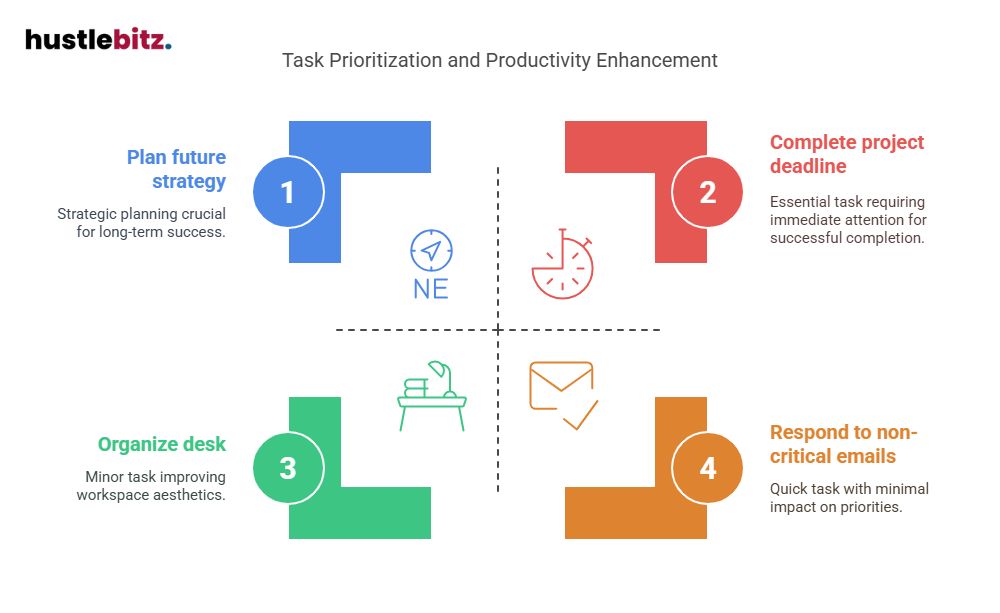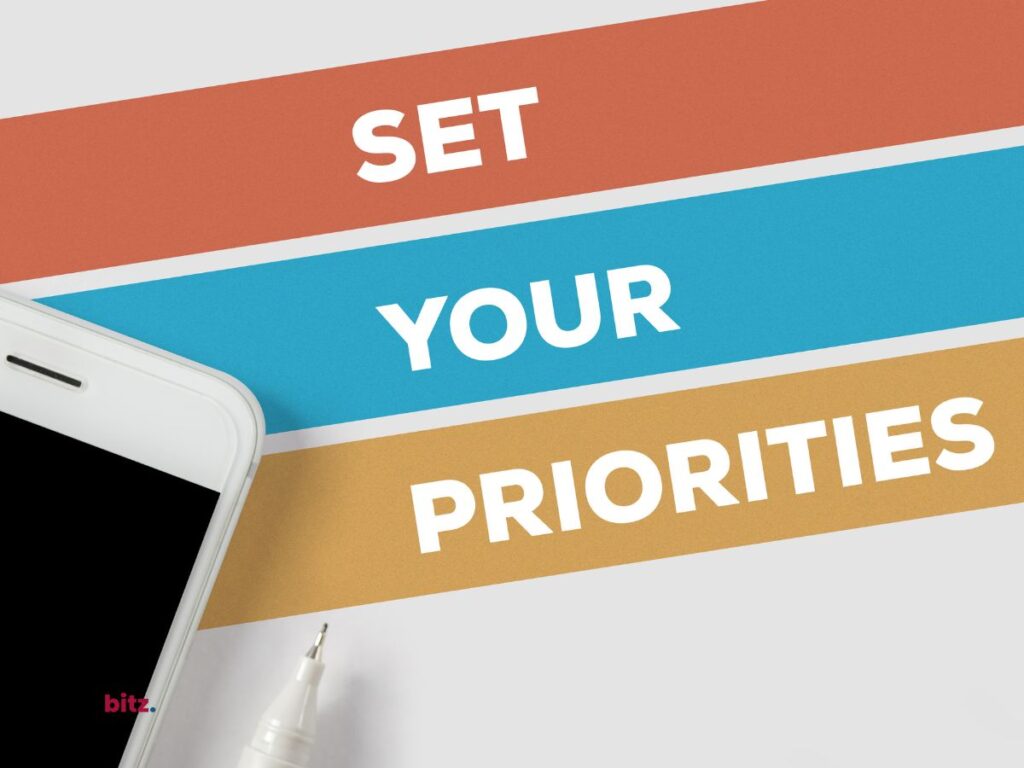To increase productivity at work, implement proven strategies like setting clear, SMART goals that foster commitment. Prioritize tasks using the Eisenhower Matrix to focus on what’s urgent and important. Employ time management techniques such as the Pomodoro Technique, which promotes focused work sessions. Optimize your workspace by decluttering and creating designated areas for essential tasks, while limiting distractions through quiet zones or using noise-canceling headphones. Taking regular breaks enhances mental clarity and creativity. Lastly, leverage technology tools to streamline processes and improve communication. Explore further strategies to maximize your productivity potential.
Key Takeaways
- Set clear, SMART goals to provide direction and enhance employee engagement and commitment.
- Prioritize tasks using the Eisenhower Matrix to focus on urgent and important activities first.
- Optimize your workspace by decluttering and organizing tools to foster better focus and efficiency.
- Limit distractions by establishing work boundaries and utilizing website blockers when necessary.
- Take regular breaks to sustain mental clarity and enhance overall productivity throughout the day.

Set Clear Goals

Setting clear goals is essential for enhancing productivity, as they provide direction and measurable outcomes for individuals and teams. When employees understand what is expected of them, they can align their efforts towards achieving specific objectives. This clarity fosters a sense of purpose, which is crucial for maintaining motivation and focus in the workplace.
To effectively set clear goals, organizations should implement strategies to boost their workforce. These strategies may include utilizing the SMART criteria—ensuring that goals are Specific, Measurable, Achievable, Relevant, and Time-bound. By following this framework, teams can create objectives that are not only attainable but also challenging enough to stimulate growth and innovation.
Moreover, effective strategies for goal-setting should involve open communication. Engaging employees in the goal-setting process allows them to contribute their insights and fosters a sense of ownership over their tasks. This collaboration can lead to enhanced workforce productivity, as individuals are more likely to be committed to achieving goals they helped create.
Additionally, regular progress reviews are vital. By assessing advancements towards the established goals, teams can identify any obstacles and make necessary adjustments, thereby maintaining momentum. This continuous feedback loop not only helps in achieving immediate objectives but also contributes to long-term success.
Prioritize Your Tasks

Effectively prioritizing tasks is crucial for maximizing productivity, as it enables individuals to focus their efforts on the most important and time-sensitive activities. By adopting clear strategies to prioritize tasks, employees can work smarter and enhance their productivity and efficiency. Establishing a systematic approach to task management not only helps in meeting deadlines but also reduces stress and fosters a more organized work environment.
One effective method is to categorize tasks based on urgency and importance. The Eisenhower Matrix is a widely recognized framework that helps in this regard. Below is a table illustrating this approach:
| Urgent & Important | Not Urgent & Important | Urgent & Not Important |
| Do these tasks first | Schedule these tasks | Delegate these tasks |
| Example: Project deadlines | Example: Strategic planning | Example: Daily meetings |
| Not Urgent & Not Important |
| Eliminate these tasks |
| Example: Unnecessary emails |
Use Time Management Techniques
In addition to prioritizing tasks, implementing effective time management techniques can significantly enhance productivity by allowing individuals to allocate their time strategically across various responsibilities.
Utilizing structured time management strategies to improve work efficiency is essential for maximizing output. One such strategy is the Pomodoro Technique, which encourages focused work sessions followed by short breaks, thereby maintaining high levels of concentration and reducing burnout.
Another proven strategy to increase productivity involves setting specific, measurable goals within defined time frames. By breaking larger projects into smaller, manageable tasks, individuals can monitor their progress and adjust their efforts accordingly. This approach not only leads to enhanced work efficiency but also fosters a sense of accomplishment as each task is completed.
Time blocking is another powerful technique where individuals allocate specific blocks of time for various activities throughout the day. This practice minimizes the likelihood of multitasking, which can often hinder productivity rather than enhance it. By dedicating concentrated periods to particular tasks, individuals can maintain focus and significantly boost productivity.
Moreover, regularly reviewing and adjusting one’s schedule allows for the identification of time-wasting activities and the opportunity to refine workflows. By adopting these time management techniques, individuals can create a structured environment conducive to achieving their goals while maintaining a healthy work-life balance.
Ultimately, mastering time management is a key element in the pursuit of sustained productivity and enhanced overall performance in the workplace.
Limit Distractions

Limiting distractions is essential for maintaining focus and enhancing productivity in today’s fast-paced work environment. Distractions can come from various sources, including digital devices, open office layouts, and even noise from colleagues. By implementing effective strategies to enhance concentration, organizations can create a more conducive atmosphere for work, ultimately leading to improved employee engagement and performance.
One effective strategy to limit distractions is to establish clear boundaries around work hours. Encourage employees to set specific times for checking emails or messages, which can help minimize interruptions throughout the day.
Additionally, creating designated quiet zones within the workplace can provide employees with a space to concentrate without the usual distractions that may arise in a more open setting.
Another approach is to leverage technology to boost your workforce productivity. Tools such as website blockers can help employees avoid time-wasting sites during work hours.
Furthermore, encouraging the use of noise-canceling headphones can significantly reduce auditory distractions, allowing employees to focus more effectively on their tasks.
Regular training sessions on time management and personal organization can also provide employees with the skills necessary to limit distractions.
Take Regular Breaks
Taking regular breaks is crucial for maintaining mental clarity and sustaining productivity throughout the workday. In today’s fast-paced work environment, the importance of stepping away from tasks cannot be overstated. Research shows that short, frequent breaks can significantly enhance focus and creativity, ultimately leading to improved productivity at work.
Incorporating breaks into your work routine is one of the most effective strategies for improving overall efficiency. A well-timed pause allows the brain to recharge, mitigating fatigue and stress that often accompany prolonged periods of concentration. This practice not only fosters a more positive work environment but also encourages employees to return to their tasks with renewed energy and focus.
There are various strategies for improving break effectiveness. For instance, the Pomodoro Technique—working for 25 minutes followed by a 5-minute break—has been widely adopted due to its effectiveness in maintaining high levels of concentration. Additionally, longer breaks, such as a lunch hour, should be utilized to step outside, engage in light physical activity, or practice mindfulness techniques.
Optimize Your Workspace

Creating an organized and inspiring workspace is essential for enhancing productivity and fostering a positive work environment. To optimize your workspace, it is crucial to focus on factors that contribute to an efficient workplace. A clutter-free and well-structured area allows employees to concentrate better, reducing distractions that can hinder workplace productivity.
Start by decluttering your desk and removing unnecessary items that may disrupt your workflow. Organizing essential tools and materials in designated spots not only saves time but also promotes a sense of order. Implementing storage solutions, such as shelves or file cabinets, can further enhance organization and accessibility.
Moreover, consider the layout of your workspace. Open spaces can encourage collaboration, while designated quiet zones can facilitate focused work. Utilizing flexible work arrangements, such as adjustable desks or modular furniture, allows employees to tailor their environment to their personal preferences, which is a proven strategy to boost productivity.
Lighting also plays a critical role in optimizing your workspace. Natural light is preferable, as it can enhance mood and focus. If natural light is limited, investing in adjustable lighting solutions can help create a more inviting atmosphere.
Leverage Technology Tools

Utilizing technology tools effectively can significantly enhance productivity by streamlining tasks and improving communication among team members. In today’s fast-paced work environment, leveraging technology tools is essential for achieving optimal team productivity.
By integrating productivity apps and project management software into daily operations, organizations can facilitate better task management, ensuring that projects stay on track and deadlines are met.
Productivity apps can help individuals prioritize their tasks, set reminders, and track progress, while project management software provides a centralized platform for collaboration. These tools enable team members to share documents, assign tasks, and communicate in real-time, reducing the need for lengthy email threads and meetings. By fostering a culture of transparency, everyone can stay informed about project statuses, which ultimately aids in decision-making.
Additionally, technology tools can automate repetitive tasks, freeing employees to focus on higher-value activities. For instance, automated reporting features in project management software can save hours of manual data entry, allowing teams to allocate their time more effectively.
Furthermore, utilizing cloud-based solutions ensures that team members can access essential information from anywhere, promoting flexibility and responsiveness.
To maximize the benefits of these tools, it is crucial to provide training and support to employees, ensuring they feel confident using them. By embracing technology and integrating it into the workflow, organizations can create an environment conducive to increased productivity and enhanced team collaboration.
Implement the Pomodoro Technique

Implementing the Pomodoro Technique can significantly enhance focus and productivity by breaking work into manageable intervals, typically 25 minutes long, followed by short breaks. This structured approach allows individuals to maintain high levels of concentration while preventing burnout, a common challenge in today’s fast-paced work environments. Understanding what productivity means in the context of work processes is essential for maximizing productivity.
The Pomodoro Technique not only organizes time effectively but also builds momentum, as each completed interval offers a sense of accomplishment. By incorporating this method into daily routines, employees can systematically tackle tasks while reducing distractions.
Here’s a simple breakdown of the Pomodoro Technique:
| Interval | Activity | Purpose |
| 1 | Work for 25 mins | Focus on one task |
| 2 | Take a 5-min break | Rest and recharge |
| 3 | Repeat 4 times | Maintain sustained effort |
| 4 | Take a longer break (15-30 mins) | Reflect and reset |
| 5 | Start a new cycle | Begin fresh with renewed focus |
These proven strategies to help improve productivity can be easily integrated into any work setting. By committing to implement the Pomodoro Technique, individuals can create a disciplined yet flexible work environment, ultimately leading to better outcomes and increased job satisfaction. Embrace this method to enhance your overall productivity and effectiveness in your professional life.
Final Thoughts
Increasing productivity at work involves implementing proven strategies that focus on goal-setting, time management, and optimizing your work environment. By setting clear, SMART goals and prioritizing tasks effectively, you can ensure that your efforts are directed towards meaningful outcomes. Techniques like the Pomodoro Technique and time blocking can help you manage your time more efficiently, while regular breaks and a well-organized workspace contribute to sustained focus and creativity. Leveraging technology tools further enhances communication and streamlines processes, allowing you to work smarter, not harder. By integrating these strategies into your daily routine, you can achieve greater productivity, reduce stress, and improve overall job satisfaction.




